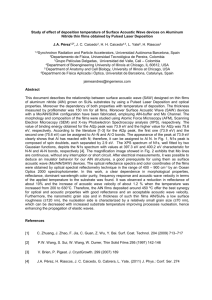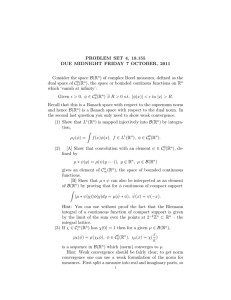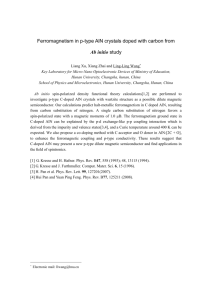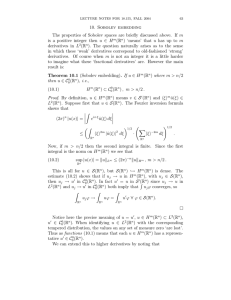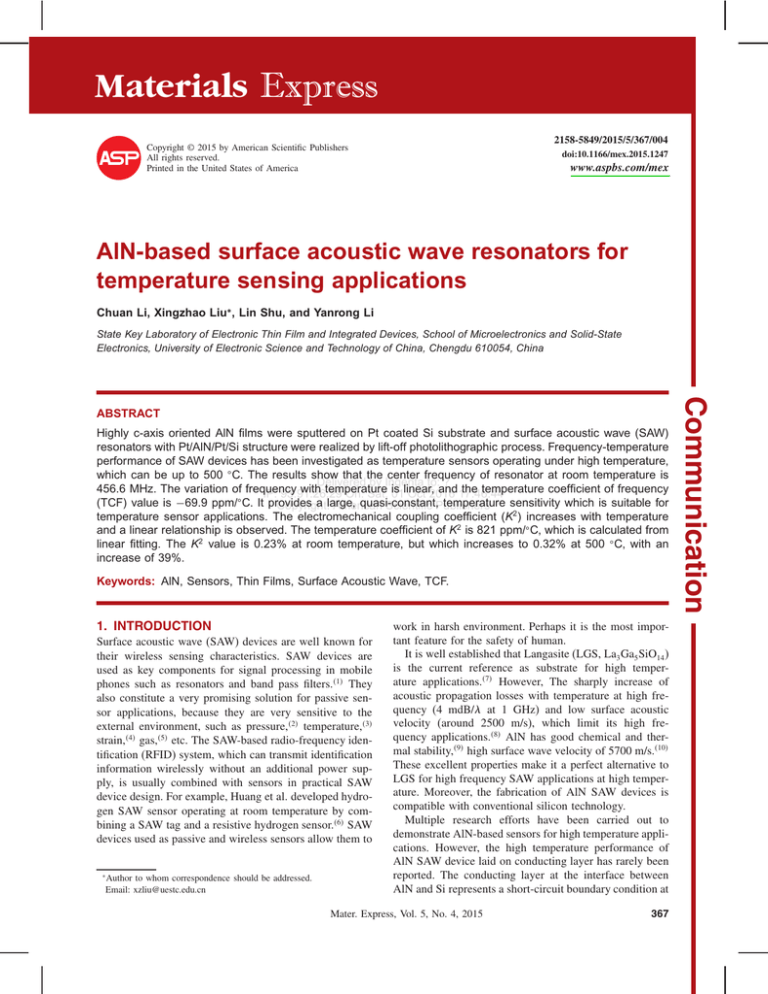
Materials Express
2158-5849/2015/5/367/004
Copyright © 2015 by American Scientific Publishers
All rights reserved.
Printed in the United States of America
doi:10.1166/mex.2015.1247
www.aspbs.com/mex
AlN-based surface acoustic wave resonators for
temperature sensing applications
Chuan Li, Xingzhao Liu∗ , Lin Shu, and Yanrong Li
State Key Laboratory of Electronic Thin Film and Integrated Devices, School of Microelectronics and Solid-State
Electronics, University of Electronic Science and Technology of China, Chengdu 610054, China
Highly c-axis oriented AlN films were sputtered on Pt coated Si substrate and surface acoustic wave (SAW)
resonators with Pt/AlN/Pt/Si structure were realized by lift-off photolithographic process. Frequency-temperature
performance of SAW devices has been investigated as temperature sensors operating under high temperature,
which can be up to 500 C. The results show that the center frequency of resonator at room temperature is
Delivered by Ingenta to: ?
456.6 MHz. The variation of frequency
with temperature
and 17:46:44
the temperature coefficient of frequency
IP:
93.91.26.29
On: Sat, is
01linear,
Oct 2016
a large,
quasi-constant,
temperature sensitivity which is suitable for
(TCF) value is −69.9 ppm/ C. It provides
Copyright:
American
Scientific Publishers
temperature sensor applications. The electromechanical coupling coefficient (K2 ) increases with temperature
and a linear relationship is observed. The temperature coefficient of K2 is 821 ppm/ C, which is calculated from
linear fitting. The K2 value is 0.23% at room temperature, but which increases to 0.32% at 500 C, with an
increase of 39%.
Keywords: AlN, Sensors, Thin Films, Surface Acoustic Wave, TCF.
1. INTRODUCTION
Surface acoustic wave (SAW) devices are well known for
their wireless sensing characteristics. SAW devices are
used as key components for signal processing in mobile
phones such as resonators and band pass filters.1 They
also constitute a very promising solution for passive sensor applications, because they are very sensitive to the
external environment, such as pressure,2 temperature,3
strain,4 gas,5 etc. The SAW-based radio-frequency identification (RFID) system, which can transmit identification
information wirelessly without an additional power supply, is usually combined with sensors in practical SAW
device design. For example, Huang et al. developed hydrogen SAW sensor operating at room temperature by combining a SAW tag and a resistive hydrogen sensor.6 SAW
devices used as passive and wireless sensors allow them to
∗
Author to whom correspondence should be addressed.
Email: xzliu@uestc.edu.cn
work in harsh environment. Perhaps it is the most important feature for the safety of human.
It is well established that Langasite (LGS, La3 Ga5 SiO14 )
is the current reference as substrate for high temperature applications.7 However, The sharply increase of
acoustic propagation losses with temperature at high frequency (4 mdB/ at 1 GHz) and low surface acoustic
velocity (around 2500 m/s), which limit its high frequency applications.8 AlN has good chemical and thermal stability,9 high surface wave velocity of 5700 m/s.10
These excellent properties make it a perfect alternative to
LGS for high frequency SAW applications at high temperature. Moreover, the fabrication of AlN SAW devices is
compatible with conventional silicon technology.
Multiple research efforts have been carried out to
demonstrate AlN-based sensors for high temperature applications. However, the high temperature performance of
AlN SAW device laid on conducting layer has rarely been
reported. The conducting layer at the interface between
AlN and Si represents a short-circuit boundary condition at
Mater. Express, Vol. 5, No. 4, 2015
367
Communication
ABSTRACT
Materials Express
AlN-based surface acoustic wave resonators for temperature sensing applications
Li et al.
the corresponding interface. Moreover, the interface electrode potential would affect the performance of the SAW
device significantly.11 In this paper, the performance of
the AlN/Pt/Si structure (leave the interface electrode floating) for SAW resonators at high temperatures was investigated. The AlN thin films were deposited on Pt electrode
by a two-step growth method in order to obtain high quality c-axis oriented texture.12 The focus in our research
is the high temperature performance of AlN SAW device
with the presence of interface electrode.
Communication
2. EXPERIMENTAL DETAILS
AlN thin films were deposited on Pt (50 nm)/Si substrates
by middle frequency (MF) reactive magnetron sputtering
of metallic aluminum targets (Alfa Aesar, 99.999%) in a
N2 /Ar mixture. A two-step growth method was used to
prepare AlN film at room temperature. In order to mitigate the effect of the lattice mismatch between AlN (0 0
0 2) and Pt (111), a 200 nm thick N -rich AlN buffer layer
was first deposited on Pt interface electrodes. The flow rate
ratio of the N2 to Ar was kept at 40/60 SCCM (SCCM
denotes cubic centimeter per minute at standard temperature and pressure). In the second stage, Stoichiometric
AlN film was deposited for a N2 /Ar ratio of 20/80 SCCM.
Finally, a layer of 2 m AlN film was obtained by adjustDelivered by Ingenta to: ?
ing deposition time.
IP: 93.91.26.29 On: Sat, 01 Oct 2016 17:46:44
One-port Rayleigh-mode SAW (R-SAW)
resonator
with Scientific Publishers
Copyright:
American
Ti/Pt electrodes (10 nm/140 nm) was fabricated by e-beam
evaporation and lift-off photolithography techniques. The
SAW resonators were design as follows: the interdigital transducers (IDTs) contains 101 equal-interval-finger
electrodes with a pitch of 3 m and each reflector contains 400 short-circuited gratings. The aperture W is 100,
where is the acoustic wave length. The normalized thickness (hAlN /) of this structure was 0.17.
The morphology of AlN films was investigated by scanning electron microscope (SEM, Inspect F50) and atomic
force microscopy (AFM, SEIKO SPA300HV). The –
2 scan and rocking curve () were obtained by X-ray
diffractometer (XRD, Bede D1) using the Cu–k doublet. The SAW devices were wired and placed in a heating apparatus. The entire SAW device was heated from
Fig. 1. (a) The –2 XRD scan pattern of AlN thin film while the
25 to 500 C under the heating rate of 5 C/min. The
inset shows the rocking curve of AlN peak. (b) 3D AFM image of AlN
apparatus dwelled at each testing temperature for about
film in a range of 10 × 10 m. (c) SEM image of the cross-sectional
10 minutes before the temperature stabilised and the mearegion where IDT finger was covered, and the inset shows the schematic
surements were taken. The frequency responses of resof the SAW resonator.
onators in reflection (S11 ) were measured using vector
network analyzer (VNA, Agilent E5071B).
the rocking curve of AlN (0002) reflection was 3.85. No
preferred in-plane orientation was observed. The surface
3. RESULTS AND DISCUSSION
morphology was characterized using AFM. As shown in
The crystalline structure was determined by XRD as
Figure 1(b), the three-dimensional (3D) AFM image of
shown in Figure 1(a). The diffraction peaks correspond
AlN film reveal a homogeneous surface without abnorto a hexagonal AlN (0002) peak and a cubic Pt (111)
mally grown grains. The root mean square (rms) roughness
peak. The full width at half maximum (FWHM) value of
value of AlN film is 5.1 nm. Low surface roughness is
368
Mater. Express, Vol. 5, 2015
Materials Express
AlN-based surface acoustic wave resonators for temperature sensing applications
Li et al.
a key point for low propagation losses. In our case, The
AlN films deposited on Pt interface electrodes have meet
the requirements for SAW device fabrication. The crosssectional SEM image and schematic of SAW resonator is
shown in Figure 1(c). The SEM image shows a multiplayer structure. The columnar texture of AlN film could
be observed in the picture obviously.
Now, if we compare the frequency response obtained
at RT (25 C) and at 500 C, we can observe as it is
clearly shown in Figure 2(a), that the frequency response
(S11 magnitude) decrease with temperature. Obviously, the
center frequency (fc ) has significantly reduced while testing temperature grows up to 500 C. Moreover, the amplitude also obviously attenuated. As we know, fc is related
to SAW propagation velocities (SAW ) and wavelength ()
follows the formula:
fc =
SAW
(1)
K2 =
Fig. 2. (a) S11 performance of SAW resonators at 25 C and 500 C
respectively. (b) Frequency variation versus temperature for SAW resonator. (c) Relative variation of K 2 versus temperature measured on
SAW resonator.
Mater. Express, Vol. 5, 2015
2free − metal Gfc =
free
4N Bfc (2)
where free and metal are the SAW phase velocities along
the free and electrically short-circuited surfaces of the AlN
film, N is the number of finger pairs of IDT, G(fc ) and
B(fc ) are the radiation conductance and susceptance measured by Smith chart at center frequency. The relationship between K 2 coefficient and temperature is plotted in
Figure 2(c), and the K 2 coefficient increases with temperature. This phenomenon is attributed to the piezoelectric
369
Communication
The temperature behavior of S11 is attributed to thermal expansion and lattice vibration. Obviously, thermal
expansion would enlarge finger size and space, result in
the increase of . The lattice vibration increases significantly with temperature. Therefore, propagation loss
would increase with increasing in acoustic scattering. The
SAW resonant frequency shifted from 456.6 MHz at 25 C
to 440.1 MHz at 500 C, providing a 3.6% frequency
change. This value is 3.5 times larger than LGS based
temperature sensor reported by Canabal.3
To evaluate the frequency-versus-temperature behavior of the studied structure, the SAW device was
heated from 25 to 500 C for three circulations. The
relationship between frequency and temperature is plotted in Figure 2(b), a first-order linear frequency-versustemperature behavior has been displayed. The temperature
coefficient
Delivered by Ingenta
to: ?of frequency (TCF) values of three heating processOct
are2016
−71.617:46:44
ppm/ C, −69.9 ppm/ C and −69.9 ppm/ C
IP: 93.91.26.29 On: Sat, 01
Copyright: American Scientific
Publishers
respectively. The calculated TCF coefficient value was
slightly decreased after the first heating, which is probably affected by annealing mechanism. The results show
that the Pt/AlN/Pt/Si structure is particularly well suited
for temperature sensor applications because it shows a
large, quasi-constant, temperature sensitivity up to at least
500 C. However, the frequency response was too weak to
be detected when the temperature above 550 C. Further
study is necessary to improve the performance of the SAW
device.
The electromechanical coupling coefficient is an inherent characteristic of the acoustic wave propagation in a
given piezoelectric medium which represents empirically
the piezoelectric strength of the acoustic wave mode.13 It
should be noted that the K 2 of SAW resonator has no direct
physical meaning. It is determined by S11 parameter with
the equation derived from Smith’s equivalent model:14 15
Communication
Materials Express
AlN-based surface acoustic wave resonators for temperature sensing applications
Li et al.
coefficient of AlN film increases with temperature.16 It
should be noted that the K 2 coefficient obtained between
25–100 C at the first heating were little lower than later
tests which demonstrates that the Pt/AlN/Pt/Si structure
is enhanced after the first heating or rather annealing at
500 C. Lin et al. reported that the AlN Lamb wave
resonators with the electrically floating bottom electrode
provides a larger effective coupling coefficient than the
grounded and open one.11 This similar phenomenon has
also been found in our study. The AlN resonator with the
floating bottom electrode shows a K 2 of 0.23%, presenting a 15% enhancement in K 2 over that without bottom
electrode (0.2%) at room temperature. It is considered that
the floating bottom electrode could reduce the additional
parasitic capacitances and increase the parallel resonance
frequency and consequently enhance the K 2 . Moreover,
the K 2 value increase from 0.23% at room temperature to
0.32% at 500 C with an increase of 39% is observed.
Interestingly, we found that the K 2 coefficient quasi-linear
increases with temperature. The temperature coefficient
of K 2 is 821 ppm/ C, which is calculated from linear
fitting.
Technology Innovation
(No. 2011JTD0006).
Research
Team
Funding
References and Notes
1. D. Morgan; Surface Acoustic Wave Filters with Application to Communications and Signal Processing; 2nd edn., Elsevier Academic
Press, Waltham (2007).
2. Q. Jiang, X. M. Yang, H. G. Zhou, and J. S. Yang; Analysis of surface
acoustic wave pressure sensors; Sens. Actuators A. 118, 1 (2005).
3. A. Canabal, P. M. Davulis, G. M. Harris, and M. P. da Cunha;
High-temperature battery-free wireless microwave acoustic resonator
sensor system; Electron. Lett. 46, 471 (2010).
4. C. Fua, K. Lee, S. S. Yang, and W. Wang; A stable and highly
sensitive strain sensor based on a surface acoustic wave oscillator;
Sens. Actuators A. 218, 80 (2014).
5. C. Lim, W. Wang, S. Yang, and K. Lee; Development of SAW-based
multi-gas sensor for simultaneous detection of CO2 and NO2 ; Sens.
Actuators B 154, 9 (2011).
6. Y. S. Huang, Y. Y. Chen, and T. T. Wu; A passive wireless hydrogen surface acoustic wave sensor based on Pt-coated ZnO nanorods;
Nanotechnology 21, 095503 (2010).
7. J. A. Thiele and M. P. da Cunha; High temperature LGS SAW gas
sensor; Sens. Actuators B 113, 816 (2006).
8. T. Tubert, M. B. Assouar, O. Legrani, O. Elmazria, C. Tiusan, and
S. Robert; Highly textured growth of AlN films on sapphire by magnetron sputtering for high temperature surface acoustic wave applications; J. Vac. Sci. Technol. A 29, 021010 (2011).
4. CONCLUSION
9. C. M. Lin, Y. Y. Chen, V. V. Felmetsger, W. C. Lien, T. Riekkinen,
Highly c-axis oriented AlN film was prepared by MF
D. G. Senesky, and A. P. Pisano; Surface acoustic wave devices
to: ?
on AlN/3C–SiC/Si
multilayer structures; J. Micromech. Microeng.
reactive magnetron sputtering with the FWHMDelivered
value wasby Ingenta
IP:
93.91.26.29
On:
Sat,
01
Oct
2016
17:46:44
23,
025019
(2013).
3.85 . Then, SAW resonators with Pt/AlN/Pt/Si structure
Copyright: American Scientific
Publishers
10. C. Deger,
E. Born, H. Angerer, O. Ambacher, M. Stutzmann,
were fabricated by lift-off photolithography techniques.
J. Hornsteiner, E. Riha, and G. Fischerauer; Sound velocity of
The floating bottom electrode represents a short-circuit
Alx Ga1−x N thin films obtained by surface acoustic-wave measureboundary condition at the corresponding interface. To
ments; Appl. Phys. Lett. 72, 2400 (1998).
11. C. M. Lin, V. Yantchev, J. Zou, Y. Y. Chen, and A. P. Pisano; Microevaluate the frequency-versus-temperature behavior of the
machined one-port aluminum nitride lamb wave resonators utilizing
studied structure, the SAW device was heated from 25
the lowest-order symmetric mode; J. Microelectromech. Syst. 23, 78
to 500 C for three circulations. The experiment results
(2014).
showed that the variation of frequency with temperature
12. C. Li, L. Shu, L. J. He, and X. Z. Liu; High quality AlN thin films
showed good linear behavior. The center frequency of
deposited by middle- frequency magnetron sputtering at room temresonator at room temperature was 456.6 MHz, and the
perature; Mater. Sci. Forum. 787, 227 (2014).
13. K. Hashimoto; Surface Acoustic Wave Devices in TelecommunicaTCF coefficient was −69.9 ppm/C. The K 2 coefficient
tions: Modelling and Simulation; Springer-Verlag, Berlin (2000).
increased quasi-linearly from 0.23% at room temperature
14. E. Blampain, O. Elmazria, T. Aubert, B. Assouar, and O. Legrani;
to 0.32% at 500 C, with an increase of 39%. The temSurface Acoustic Wave sensor based on AlN/sapphire structure for
perature coefficient of K 2 was 821 ppm/C. Based on the
high temperature and high frequency applications; Proceedings of
reported experimental results herein, AlN resonator with
the 10th Annual IEEE Conference on Sensors, Limerick, Ireland,
October (2011), p. 610.
the Pt floating bottom electrode provide a large, quasi15. C. C. Sung, Y. F. Chiang, R. Ro, R. Lee, and S. Wu; Effects of conconstant, temperature sensitivity which is suitable for temducting layers on surface acoustic wave in AlN films on diamond;
perature sensor applications.
J. Appl. Phys. 106, 124905 (2009).
16. C. M. Lin, T. T. Yen, V. V. Felmetsger, M. A. Hopcroft, J. H.
Acknowledgments: This work is supported by
Kuypers, and A. P. Pisano; Thermally compensated aluminum nitride
the National Nature Science Foundation of China
lamb wave resonators for high temperature applications; Appl. Phys.
Lett. 97, 083501 (2010).
(No. 61223002) and Sichuan Youth Science and
Received: 3 December 2014. Revised/Accepted: 17 March 2015.
370
Mater. Express, Vol. 5, 2015

